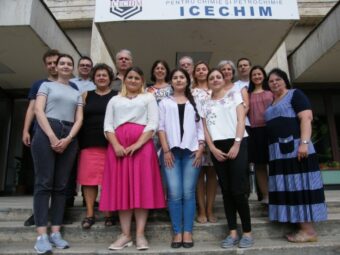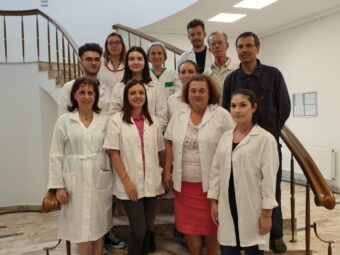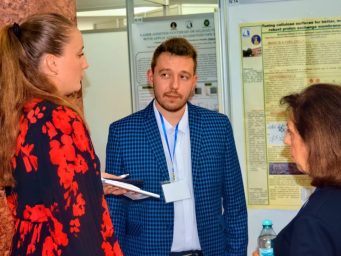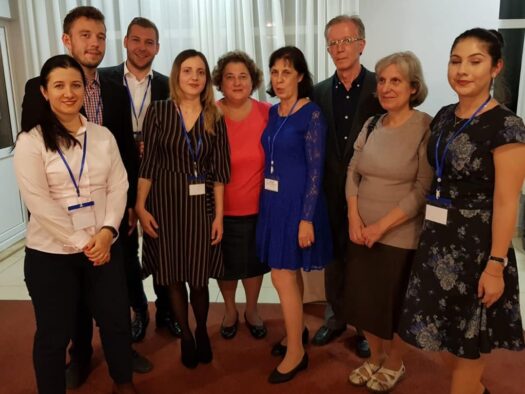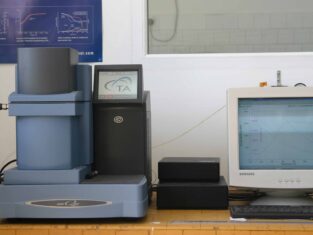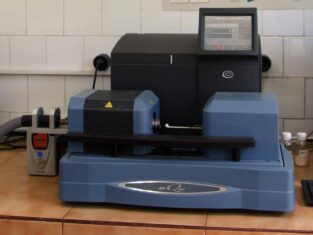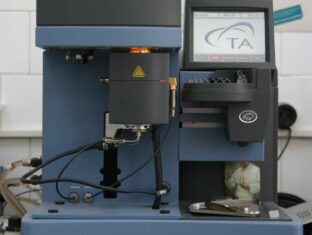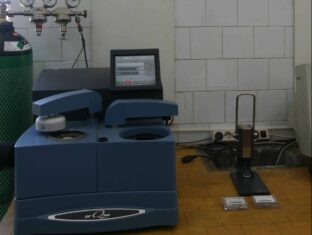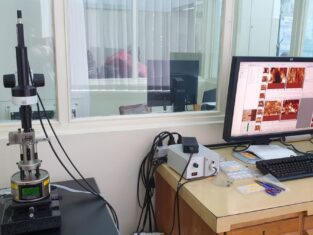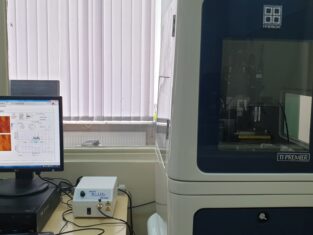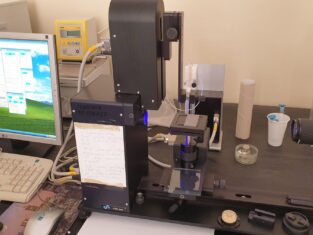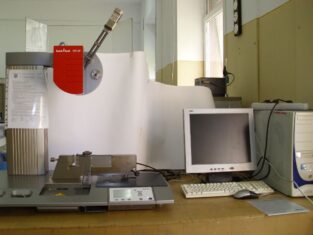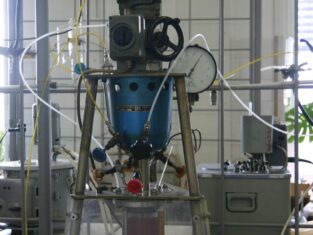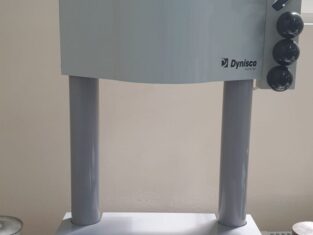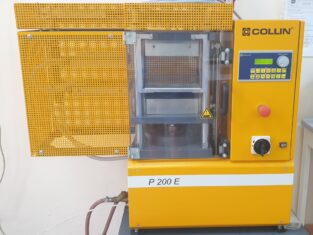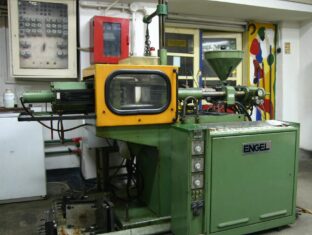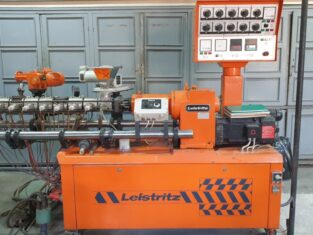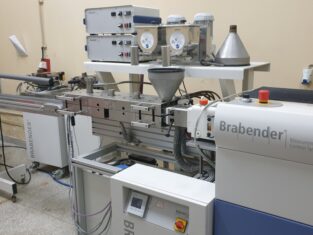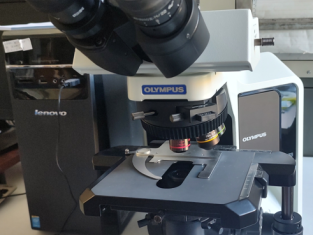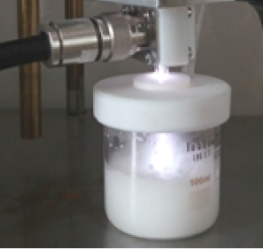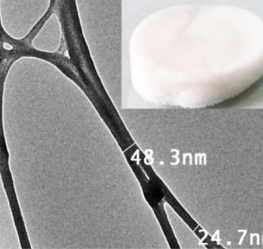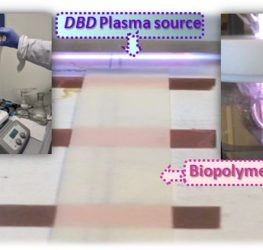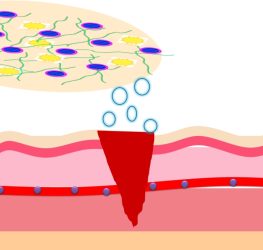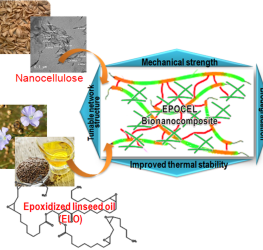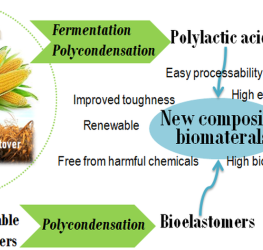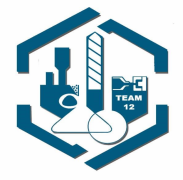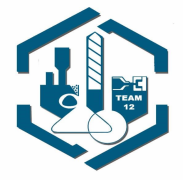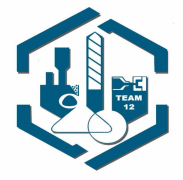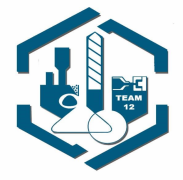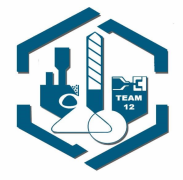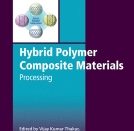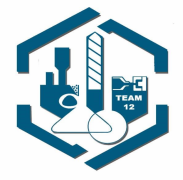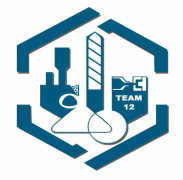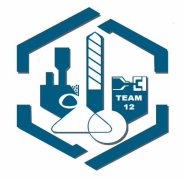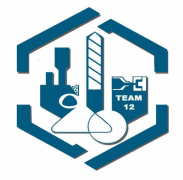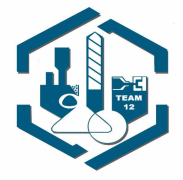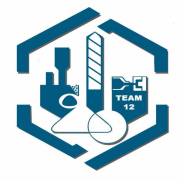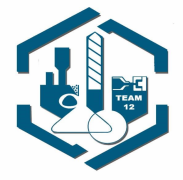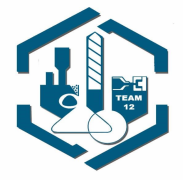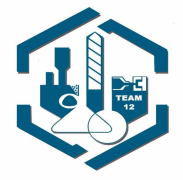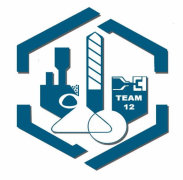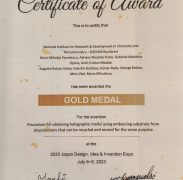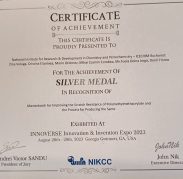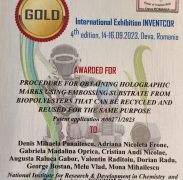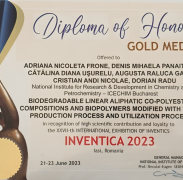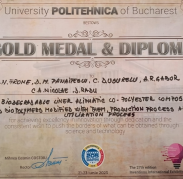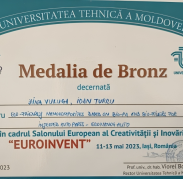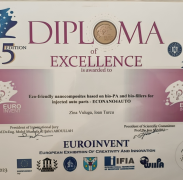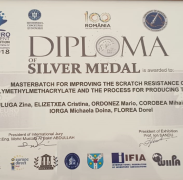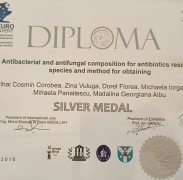G12: Polymeric composites and nanocomposites
The Research Activity of Team 12 – Polymer Composites and Nanocomposites is focused on the development of multifunctional polymer composites and nanocomposites based on synthetic and/or natural polymers and various synthetic and/or natural micro/nano fillers, with low impact on the environment or biodegradable and with improved specific properties, imposed by different applications in industry (automotive and packaging), construction, agriculture and biomedicine. Consequently, the research directions considered are focused, on the one hand, on the characterization, physical or chemical modification and processing of both the components and the resulting (nano)composites, and on the other hand, on the processes for obtaining and interaction mechanisms. The main objectives of Team 12’s research are to improve processability and replace, as far as possible, toxic additives and synthetic polymers with materials isolated from natural and renewable resources. In the last 10 years, within national and European projects (FP6, FP7 and Horizon 2020), Team 12 has gained knowledge and experience in developing technologies for obtaining (nano)composites, both based on synthetic polymers (PP, PMMA, thermoplastic elastomer, silicone rubber) with different (nano)fillers (natural nanosilicates, with lamellar or tubular morphology, silica nanowires, natural fibres, nanosilica, calcium metasilicate) as well as based on biopolymers (bio-polyamide, aliphatic polyesters, collagen and cellulose) with different reinforcing agents (graphene and non-graphene 2D structures, cellulose nanofibers), implemented and validated to TRL 5-TRL 9, for the manufacture of: • High quality automotive components (bumper, spare wheel well, B-pillar) • Food packaging • Biomedical products • Protective coatings
Nanocellulose based biocomposites with integrated antibacterial activity by submerged liquid plasma (CELLAB-SLP)
The objective of the project is to develop a new biomaterial with integrated antibacterial activity and a technology to obtain this biomaterial.
Nanocellulose 3-D structures for regenerative medicine (CELL-3D)
CELL-3D has as main objective to design new 3D nanocellulose structures for tissue engineering with chemical, mechanical and structural properties needed in regenerative medicine.
Biopolymer structures obtained by plasma treatment for wounds healing – BIOPLASM
The scope of the project is to obtain effective dressings for the treatment of infected wounds by developing antibacterial nanocellulose nanocarriers deposited on an aliphatic polyester substrate.
Design of new nanocellulose-based gas-carrier systems
The scope of the CELGAS project is to develop innovative oxygen-carrying systems capable of supplying oxygen in a controlled manner to injured tissue/implants or intravenously.
Bio-based nanocomposites from epoxy-celullose with balanced thermo-mechanical properties – EPOCEL
The proposed project aims to develop new nanocomposites, based on renewable and inexpensive biological sources, with thermo-mechanical balanced properties for applications in electronics.
New materials based on polylactic acid with controlled flexibility – FLEX4PLA
FLEX4PLA project aims the research and design of new biomaterials in which both polymers and additives are being derived from renewable resources.
Adriana N. Frone, Catalina D. Usurelu, Gabriela M. Oprica, Denis M. Panaitescu, Augusta R. Gabor, Cristian A. Nicolae, Florin Ciuprina, Celina M. Damian
Contribution of the Surface Treatment of Nanofibrillated Cellulose on the Properties of Bio-Based Epoxy Nanocomposites Intended for Flexible Electronics
International Journal of Molecular Sciences
https://doi.org/10.3390/ijms24076544
Denis M. Panaitescu, Adriana N. Frone, Cristian A. Nicolae, Augusta R. Gabor, Dana M. Miu, Mariana G. Soare, Bogdan S. Vasile, Irina Lupescu
Poly(3-hydroxybutyrate) nanocomposites modified with even and odd chain length polyhydroxyalkanoates
International Journal of Biological Macromolecules
https://doi.org/10.1016/j.ijbiomac.2023.125324
Denis M. Panaitescu, Marius S. Popa, Florin Ciuprina, Laura Enache, Adriana N. Frone, Cristian A. Nicolae, Augusta R. Gabor, Roxana Trusca, Valentin Raditoiu, Bogdan Trica, Marius Ghiurea
Role of polyaniline coating on nanosilica particles in polyvinylidene fluoride nanocomposites for energy storage
Surface and Interfaces
https://doi.org/10.1016/j.surfin.2022.102546
Oprică, G.M.; Panaitescu, D.M.; Usurelu, C.D.; Vlăsceanu, G.M.; Stanescu, P.O.; Lixandru, B.E.; Vasile, V.; Gabor, A.R.; Nicolae, C.-A.; Ghiurea, M; Frone, A.N.
Nanocellulose Sponges Containing Antibacterial Basil Extract
International Journal of Molecular Sciences
https://doi.org/10.3390/ijms241411871
Andreea Ionita (Afilipoaei), Zina Vuluga, Florin Oancea, George M. Teodorescu, Raluca A. Gabor, Cristian A. Nicolae, Malina Desliu – Avram, Jenica Puceagiu
Properties of Composites based on Recycled Polypropylene and Lignocellulosic Agricultural Waste
Revista Română de Materiale
https://solacolu.chim.upb.ro/pg94-100.pdf
Ianchis, R., Munteanu, T., Ninciuleanu, C. M., Gifu, I. C., Alexandrescu, E., Somoghi, R., Gabor, A. R., Preda, S., Nistor, C. L., Nitu, S., Petcu, C.
The Effect of Clay Type on the Physicochemical Properties of New Hydrogel Clay Nanocomposites
In: Current Topics in the Utilization of Clay in Industrial and Medical Applications, Mansoor Zoveidavianpoor, IntechOpen
978-1-83881-554-7
Corobea, M.C., Vuluga, Z., Florea, D., Miculescu, F., Voicu, S.I.
Composites and Nanocomposites Based on Polylactic Acid
Chapter 13, pp. 327-360 in: “Handbook of Composites from Renewable Materials, Nanocomposites : Advanced Applications”, Eds: Thakur V.K., Thakur M.K., Kessler M.R.,Wiley and Scrivener Publishing, 2017
978-1-11-922383-2
Donescu, D., Corobea, M.C.*, Spataru, C.I., Ghiurea, M.
Polymer carbon nanotubes composites obtained via radical polymerization in water-dispersed media
Chapter 11, pp. 281-305 in: Woodhead Publishing Series in Composites Science and Engineering “Hybrid Polymer Composite Materials Processing” 2017 Elsevier Ltd.
978-0-08-100790-7
Z. Vuluga, F. Oancea, D.M. Panaitescu, A.N. Frone, C.A. Nicolae, A.R. Gabor, A. Ionita, G.M. Teodorescu, M. Ghiurea, V. Faraon, G. Vasilievici, G.M. Oprica
Keratin/nanoparticle hybrids for bio-PA nanocomposites
XIXth Edition of the International symposium “PRIORITIES OF CHEMISTRY FOR A SUSTAINABLE DEVELOPMENT” (PRIOCHEM XIX 2023), Bucharest, Romania, October 11-13, 2023
G.-M. Oprica, C.D. Usurelu, A.N. Frone, B.E. Lixandru, V. Vasile, M. Ghiurea, A.R. Ghiurea, C.-A. Nicolae, P.O. Stanescu, D.M. Panaitescu
Treatment of nanocellulose by antibacterial agents of natural origin
XIXth Edition of the International symposium “PRIORITIES OF CHEMISTRY FOR A SUSTAINABLE DEVELOPMENT” (PRIOCHEM XIX 2023), Bucharest, Romania, October 11-13, 2023
Ș-O. Dima, D. Constantinescu-Aruxandei, N. Tritean, M. Ghiurea, C-A. Nicolae, C. Neamtu, F. Oancea
Analytic fingerprints of Se-stimulated cabbage biofortification
XIXth Edition of the International symposium “PRIORITIES OF CHEMISTRY FOR A SUSTAINABLE DEVELOPMENT” (PRIOCHEM XIX 2023), Bucharest, Romania, October 11-13, 2023
M. Desliu-Avram, B. Trica, M.F. Raduly, C-A. Nicolae, M. Ladaniuc, D. Constantinescu-Aruxandei, D. Dimonie
The spending of wood sawdust as possibility to improve the embedding’s efficiency into renewable origin polymeric matrices
XIXth Edition of the International symposium “PRIORITIES OF CHEMISTRY FOR A SUSTAINABLE DEVELOPMENT” (PRIOCHEM XIX 2023), Bucharest, Romania, October 11-13, 2023
T. Fistos, A. Melinescu, L.M. Ditu, A. Ficai, D. Ficai, F. Marinescu, R.I. Matei (Brazdis), I. Fierascu, A.M. Baroi, C.A. Nicolae, R.C. Fierascu
Multifunctional composite materials (with consolidation, self-cleaning and antimicrobial properties) applicable for the preservation of inorganic substrates
XIXth Edition of the International symposium “PRIORITIES OF CHEMISTRY FOR A SUSTAINABLE DEVELOPMENT” (PRIOCHEM XIX 2023), Bucharest, Romania, October 11-13, 2023
R.I. Matei (Brazdis), A.M. Baroi, R.C. Fierascu, T. Fistos, I.E. Chican, G. Ivan, I.S. Hosu, C.A. Nicolae, I. Fierascu
Preliminary assessment for heavy metal removal from synthetic water matrix using an organic/inorganic composite
XIXth Edition of the International symposium “PRIORITIES OF CHEMISTRY FOR A SUSTAINABLE DEVELOPMENT” (PRIOCHEM XIX 2023), Bucharest, Romania, October 11-13, 2023
G.M. Teodorescu, Z. Vuluga, F. Oancea, A. Ionita, V. Faraon, G. Vasilievici
Mechanical, dynamic-mechanical and nanomechanical properties of biopolyamide/keratin nanocomposites
XIXth Edition of the International symposium “PRIORITIES OF CHEMISTRY FOR A SUSTAINABLE DEVELOPMENT” (PRIOCHEM XIX 2023), Bucharest, Romania, October 11-13, 2023
G.M. Teodorescu, Z. Vuluga, A.N. Frone. G.M. Oprica, C.D. Usurelu, T. Fistos, A.M. Baroi, R.I. Matei, R.A. Gabor, C.A. Nicolae
The mechanical, thermal, and nanomechanical properties of composites made of bio-based polyamide and ash powder
XIXth Edition of the International symposium “PRIORITIES OF CHEMISTRY FOR A SUSTAINABLE DEVELOPMENT” (PRIOCHEM XIX 2023), Bucharest, Romania, October 11-13, 2023
C-D. Uşurelu, G-M. Oprică, A.N. Frone, E-I. Neblea, M.F. Raduly, A.R. Gabor, C-A. Nicolae, M. Teodorescu, D.M. Panaitescu
Preparation and functionalization of nanocellulose using lactic acid: morphostructural characterization and emulsifying capacity
XIXth Edition of the International symposium “PRIORITIES OF CHEMISTRY FOR A SUSTAINABLE DEVELOPMENT” (PRIOCHEM XIX 2023), Bucharest, Romania, October 11-13, 2023
- 1
- 2

